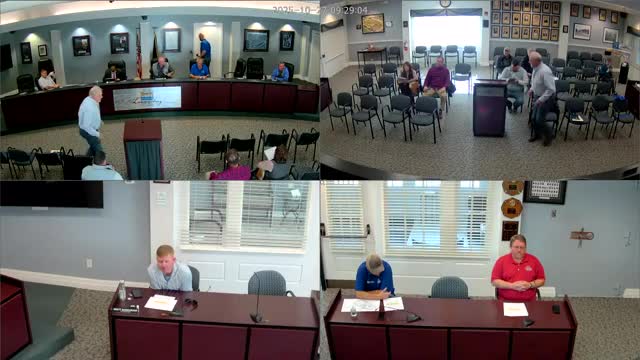Developer seeks permit to excavate 30-acre borrow area to finish Tanners Creek fly ash closure
October 28, 2025 | Lawrenceburg City, Dearborn County, Indiana
This article was created by AI summarizing key points discussed. AI makes mistakes, so for full details and context, please refer to the video of the full meeting. Please report any errors so we can fix them. Report an error »

A representative of Danner's Creek Development told a joint Lawrenceburg City Council and Utility Service Board work session on Oct. 27 that the company is seeking a grading permit to excavate Borrow Area 6, roughly 30 acres, to provide cover soil to complete closure of a former Tanners Creek fly ash pond.
Russ Becker, representing Danner's Creek Development, said the company drilled about one boring per acre across the planned borrow area, ran grain-size and permeability tests and coordinated permitting steps with state reviewers, the U.S. Army Corps of Engineers and an archaeological reviewer. Becker said the project team initially modeled that leaving 5 feet of native clay above the aquifer would mean about 600 years for vertical penetration in the lab tests; after state review the company proposes leaving roughly 10 feet of clay in place above the aquifer.
"As part of our work, obviously, we're willing to restore whatever do whatever's necessary to restore the ground to make it stable," Becker said. He described plans for a synthetic three-layer cap over the fly ash pond and a soil cover (about 30 inches) to protect the liner from roots and burrowing animals.
Atlas, the independent environmental reviewer on the call, asked for a formal hydrogeologic opinion before the council votes. "I haven't seen that," Brian Cole of Atlas said after reviewing the files; he flagged the need to address the potential for cracking in clay layers if the borrow area alternates between wet and dry conditions, the horizontal travel time and proximity to the city's well field, and whether a permanent pond, intermittent wetland or other design is appropriate.
Cole suggested alternatives such as designing a smaller, permanent pond or developing bankable wetland features and recommended documentation that directly evaluates the aquifer protection claim.
Council members and residents raised questions about long-term stewardship, floodplain effects and how using on-site soil compares with importing cover material by truck. Becker said using the borrow area would reduce truck traffic on Route 50 and accelerate closure; opponents and some council members said they prefer importing soil if that provides greater certainty of aquifer protection.
The council did not vote on the permit request at the Oct. 27 session. Officials agreed to place the permit request and the site's technical report on the Nov. 3 agenda for full board consideration after Atlas and city staff have had time to review the investigation and permeability data.
Next steps: Becker agreed to provide the site investigation/permeability report to Atlas and city staff; the council expects discussion and a possible vote at the Nov. 3 meeting.
Russ Becker, representing Danner's Creek Development, said the company drilled about one boring per acre across the planned borrow area, ran grain-size and permeability tests and coordinated permitting steps with state reviewers, the U.S. Army Corps of Engineers and an archaeological reviewer. Becker said the project team initially modeled that leaving 5 feet of native clay above the aquifer would mean about 600 years for vertical penetration in the lab tests; after state review the company proposes leaving roughly 10 feet of clay in place above the aquifer.
"As part of our work, obviously, we're willing to restore whatever do whatever's necessary to restore the ground to make it stable," Becker said. He described plans for a synthetic three-layer cap over the fly ash pond and a soil cover (about 30 inches) to protect the liner from roots and burrowing animals.
Atlas, the independent environmental reviewer on the call, asked for a formal hydrogeologic opinion before the council votes. "I haven't seen that," Brian Cole of Atlas said after reviewing the files; he flagged the need to address the potential for cracking in clay layers if the borrow area alternates between wet and dry conditions, the horizontal travel time and proximity to the city's well field, and whether a permanent pond, intermittent wetland or other design is appropriate.
Cole suggested alternatives such as designing a smaller, permanent pond or developing bankable wetland features and recommended documentation that directly evaluates the aquifer protection claim.
Council members and residents raised questions about long-term stewardship, floodplain effects and how using on-site soil compares with importing cover material by truck. Becker said using the borrow area would reduce truck traffic on Route 50 and accelerate closure; opponents and some council members said they prefer importing soil if that provides greater certainty of aquifer protection.
The council did not vote on the permit request at the Oct. 27 session. Officials agreed to place the permit request and the site's technical report on the Nov. 3 agenda for full board consideration after Atlas and city staff have had time to review the investigation and permeability data.
Next steps: Becker agreed to provide the site investigation/permeability report to Atlas and city staff; the council expects discussion and a possible vote at the Nov. 3 meeting.
View full meeting
This article is based on a recent meeting—watch the full video and explore the complete transcript for deeper insights into the discussion.
View full meeting
